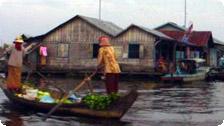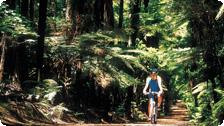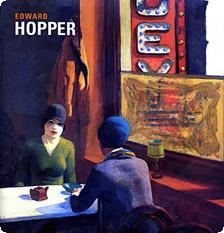by Kristina L. Mayer
The alarm rings; it is very dark and quiet. We rustle our gear into daypacks and gulp down instant espresso before quietly making our way past the night watchman sleeping on a cot covered with a mosquito net. The rustling of our gear and the soft sound of our steps wake him. He jumps up to unlock the gate where John, our driver, is already waiting.
The night before, I had discovered a short description of Prek Toal Biosphere and Bird Sanctuary in my guidebook. After the brief moment it took to convince my travel partner, Karen, that it was an adventure she wouldn’t want to miss, we had set in motion a plan to depart early the next morning.
Riding through town, we pass market merchants making their way to the dark, dank stalls where they will spend the next twelve to fourteen hours selling their wares—brightly woven baskets brimming with farm goods, hand-loomed scarves, and cloth sacks of rice. We see parents and barefoot children riding four-deep on motorcycles, women bustling to work, and stray dogs roaming the streets.
The narrow road is deeply rutted and dusty. It is dark when we arrive at the floating village of Chong Kneas. Houses on stilts line the narrow road, which is strewn with artifacts of daily life—plastic, aluminum cans, empty water vessels. A few new fires pour smoke into the early-morning sky.
John speaks to the government checkpoint agent and gestures toward the lake. He slides back into the car and we continue on, slowing to a stop at a spot where colorful wooden boats cluster on the shore. Out of nowhere, a woman appears along the barren muddy shoreline, ushering us toward a boat where two bronze-faced men hurriedly prime and start the huge diesel engine that straddles the stern, its long rudder extended behind.
It is still dark, and the sky and water are deep blue. It is hard to tell where one ends and the other begins. The motor hums along. Life in the floating village is stirring. Merchant boats overflowing with goods make their rounds, fishermen head out onto the big lake, and morning smells of cooking fill the air.
Mr. Hun, our skipper, makes only one stop, to get diesel fuel. He pulls the boat up to a dock, hops up on the deck and begins to fill the tanks. His expression is full of intent; cigarette smoke swirls around him. He disappears to pay someone and returns with a small brown paper bag, which he stows in the front of the boat near him. Everything is done in silence.
Nearly two hours slip by before we reach Prek Toal, another floating village and home to nearly eight hundred families. It is close to eight o’clock and many people are navigating the lake. Children in uniforms pass us on their way to school. We approach the Environmental Office and are greeted by a young man, who welcomes us in fluent English. He promptly turns us over to a very drawn, wrinkled man in a uniform who collects our fee and writes detailed receipts. Our guide arrives with two laminated charts displaying pictures of the birds we are likely to see. The charts turn out to be very useful, if not invaluable, as our driver and guide speak only Khmer.
After another hour of swift travel along the lake shore, we begin to see more birds than I have ever seen—Chinese Pond Heron, Grey-headed Fish Eagles, Oriental Darters, and Stork-billed King Fishers. With lots of pointing to the charts to the birds and back, we build rapport with our new Cambodian friends. They are very serious about showing off the varied nature of the biosphere, and often slow the boat to make sure we see flocks of Spot-billed Pelicans perched in trees or Blue-tailed Bee Eaters on the low-growing scrub brush.
Karen and I marvel at this extraordinary opportunity to experience the migratory pathway of so many Southeast Asian birds with these knowledgeable guides. Language separates us, but also provides us occasion to interact. Our guides’ interest in our English pronunciation of the names of the birds is as intriguing as our curiosity about their names in Khmer.
The boat approaches a marshy area. We spot a massive tree with a wooden boat tied to its base. A tall, slender man stands on the bottom rung of a set of steep bamboo steps that ascend the tree. We are surprised to learn that two researchers live and work in the elongated lateral branches of the tree for stretches of seven days at a time. Through a series of gestures and Khmer exchanges, this crew of deeply committed environmental enthusiasts explains that they are observing and recording migration patterns and nesting behaviors.
Mr. Hun suddenly brings out the brown bag from the diesel station and shows us a bottle of herb wine. He pours two glasses of wine and gestures to pass them around the circle. Someone hands out dried prunes, we break out cashews, and a celebration is underway.
The scientist invite us to climb the ladder to the work station. I choose to stay with our driver while Karen crawls over the front of the boat. She climbs up the long bamboo ladder scaling the tree, which is wrapped and bound with rope. I have the chance to study the long boat, which is the only place other than the tree for the scientists to inhabit. It serves as a place to store food and cook, and a means to gather wood.
The warm mid-day sun, wine, and good company make the afternoon fly by as we connect through our common interest in birds. On the way back to Prek Toal, Mr. Hun spots a tree full of large birds. He attempts to give us a close-up look by driving into some water strewn with shrubs.
Suddenly, the boat is stuck. The driver rocks the boat to dislodge it, but to no avail. After some conversation between our guide and the skipper, Mr. Hun strips down to his shorts and jumps into the water to lend his muscle to the problem. After a half an hour or so, the boat is free. We continue on, Mr. Hun dripping wet but content to have freed us.
When we arrive at the Environmental Office, we are greeted by a leathery-faced man who offers us lunch in a living room next door to the office. There, two women appear with a platter of whole fried fish and a large bowl of cooked greens resembling thick blades of grass.
By the time we leave the Environment Office, we have become fast friends with our driver and guide, communicating through our mutual love of the natural environment—as though language and culture were no barrier at all.
Windblown and heavy-eyed, we make the trip toward Chong Kneas, the only sounds the water rushing past and the hum of the diesel engine. Just before we make our way up the fingerlet to the village, Mr. Hun stops the boat and kneels on the soggy boat floor. He asks us to write a few words on a piece of paper with simple pictures, to keep the meaning fresh. Four English words: BIRD, NEST, EGG, and BABY.
Aw kohn, trei. and niak ch’muah ei: we have our Khmer words to take home, too.
* * * *
Kristina Mayer, Ed. D., is a seasoned world traveler, who recently founded Professional Adventures to provide rich and stimulating international educational opportunities combining adventure travel, cultural learning, and the application of learning to professional practice.
To learn more about Professional Adventures and its Cambodia Tours, email Kristina at info@klmayer.com







